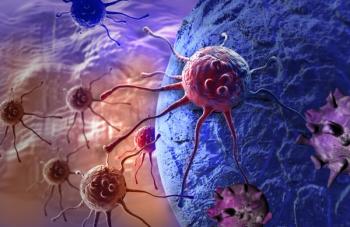
- ONCOLOGY Nurse Edition Vol 24 No 10
- Volume 24
- Issue 10
Framing the Challenges of Cancer Rehabilitation
Franklin, Delengowski, and Yeo have made a strong case for the importance of cancer rehabilitation.
Franklin, Delengowski, and Yeo have made a strong case for the importance of cancer rehabilitation. Their synthesis points to several important challenges that remain if we are to bridge the existing chasm between oncology and the rehabilitation sciences. These challenges include: (1) a paucity of outcomes evaluation metrics; (2) underdevelopment of the evidence base for cancer rehabilitation; (3) the need for workforce development; and (4) the absence of a health policy framework for cancer rehabilitation to support optimal service delivery, access to care, and reimbursement.
As Franklin and colleagues point out, the current measurement system to screen for and address oncology rehabilitation needs is suboptimal. While instruments exist to evaluate selected cancer rehabilitation outcomes, many of the standard outcome measures in rehabilitation science have had limited testing in cancer samples. Studies of established rehabilitation outcome measures are needed to examine their validity, and to establish normative values, sensitivity to change, and the minimum clinically important difference in cancer samples. Fundamental to efforts to strengthen outcomes-evaluation metrics in the field of cancer rehabilitation is the need to refine the lexicon we apply in cancer care when describing functional goals and outcomes. Terms such as performance status, functional status, functional performance, capacity and reserve, functional impairment, and functional loss may be used imprecisely in oncology specialty care, and the limited conceptual attention given to function, distinct from quality of life or symptom burden, in cancer care has slowed our progress in the areas of measurement, intervention, and policy.
The authors highlight the important role of performance-based measures in assessing rehabilitation needs. Though performance-based measures have had limited application to date in oncology,[1–5] studies in other chronic illnesses suggest that performance-based measures offer complementary and nonredundant information to that gathered by self-report.[6–8] Performance-based indicators are reproducible and safe to perform using prescribed procedures, and they avoid reporter bias as well as issues of response shift that may be inherent in patient self-report.[9] If performance-based measures are to assume a more prominent role in evaluating cancer rehabilitation outcomes, however, research is needed to gauge their psychometric and clinimetric properties in cancer populations, and to inform guidelines for interpretation including normative values and sensitivity to change at different points in the cancer treatment trajectory.
At the same time, significant progress has been made in the area of patient-reported outcome (PRO) measures for oncology rehabilitation. For example, relative to screening, the NIH Patient-Reported Outcomes Measurement Information System (PROMIS) initiative has applied contemporary psychometric approaches to the development of computer-adaptive testing(CAT) for a wide range of patient-reported outcomes of importance to rehabilitation.[10] PROMIS measures have been developed to evaluate physical functioning,[11] and to detect symptoms such as fatigue,[12] pain,[13] and depression,[14] which may be prominent contributors to declines in physical function in cancer survivors. PROMIS measures have the advantages of producing precise assessments efficiently and reliably, and do not demonstrate prominent ceiling or floor effects even when used to evaluate patients who are significantly different from the average individual. The use of a common set of metrics such as PROMIS also promotes outcomes evaluation across time and settings, and can facilitate the conduct of much-needed oncology health services research in rehabilitation settings. Guidelines for selecting patient-reported outcome measures in cancer clinical trials have been recently proposed,[15] and can be translated to guide the selection of PROs in cancer rehabilitation.
Franklin et al emphasize the importance of rehabilitation protocols to reduce and prevent functional impairment during and following cancer treatment. If such protocols are to be evidence-based, however, there is an urgent need to develop and disseminate research-tested interventions to improve functional performance and capacity. Although a limited range of rehabilitative interventions has been evaluated in patients with breast cancer and head and neck cancer, research focused on testing rehabilitative interventions in groups who have been understudied (eg, patients with multiple myeloma, brain tumors, and those with advanced disease) would fill a significant gap in our knowledge base. Technologies including the web, social networking sites, and portable computing devices have become increasingly important tools that clinicians deploy to implement research-tested interventions, support shared decision-making, improve continuity of care, and empower patient self-management.[16–18] The potential to exploit these technologies to improve access to cancer rehabilitation services deserves greater study.
To optimize the delivery of rehabilitation services in accord with the recommendations of Franklin and colleagues, it is essential that we address fundamental gaps in health policy, service delivery infrastructure, and workforce planning. Our clinical programs must be organized and staffed to address the expanding need for rehabilitation heralded by the increasing incidence of cancer, the transformation of cancer from a terminal disease to a complex chronic illness, the aging of the population, and the accompanying prevalence of comorbid conditions.[19] The fact that specialists in oncology and in the rehabilitative sciences have few formalized opportunities for joint education and scientific development has served to segregate these two domains of scientific expertise. Few oncology professionals are dual-certified in oncology and rehabilitation, and there exists no core curriculum or competencies for cancer rehabilitation. The field of cancer rehabilitation would benefit from expanded opportunities to exchange information about contemporary developments in their respective specialties, and to form partnerships in testing interventions, developing patient-centered rehabilitation models, proposing evidence-based guidelines, and advancing health policy to improve rehabilitation outcomes during and following cancer and its treatment.
The development of national standards for cancer rehabilitation could serve to accelerate these needed improvements in health professional education, service delivery, research, and health policy, and such standards have been proposed recently in Great Britain.[20] By emphasizing the importance of cancer rehabilitation in improving quality of life, the article by Franklin et al provides a timely call to action. Health professionals in oncology and rehabilitation science, and the organizations that represent us, must take the next logical step and articulate interdisciplinary, cross-specialty standards for cancer rehabilitation.
References:
References
1. Jarden M, et al: A randomized trial on the effect of a multimodal intervention on physical capacity, functional performance and quality of life in adult patients undergoing allogeneic SCT. Bone Marrow Transplant 43(9):725â737, 2009.
2. Montoya M, et al: Objective evaluation of physical function in patients with advanced lung cancer: A preliminary report. J Palliat Med 9(2):309â316, 2006.
3. Simmonds MJ: Physical function in patients with cancer: Psychometric characteristics and clinical usefulness of a physical performance test battery. J Pain Symptom Manage 24(4):404â414, 2002.
4. Simmonds MJ: The differential influence of pain and fatigue on physical performance and health status in ambulatory patients with human immunodeficiency virus. Clin J Pain 21(3):200â206, 2005.
5. Mallinson T, et al: Giving meaning to measure: Linking self-reported fatigue and function to performance of everyday activities. J Pain Symptom Manage 31(3):229â241, 2006.
6. Pollock-BarZiv SM, et al: Patients’perceptions versus medical testing of function in women with lymphangioleiomyomatosis (LAM). Respir Med 99(7):901â909, 2005.
7. Mannerkorpi K: Relationships between performance-based tests and patients’ ratings of activity limitations, self-efficacy, and pain in fibromyalgia. Arch Phys Med Rehabil 87(2):259â264, 2006.
8. Stratford PW, Kennedy DM: Performance measures were necessary to obtain a complete picture of osteoarthritic patients. J Clin Epidemiol 59(2):160â167, 2006.
9. Tierney DK, et al: Response shift: A theoretical exploration of quality of life following hematopoietic cell transplantation. Cancer Nurs 30(2): 125â138, 2007.
10. Garcia SF, et al: Standardizing patient-reported outcomes assessment in cancer clinical trials: A patient-reported outcomes measurement information system initiative. J Clin Oncol 25(32):5106â5112, 2007.
11. Bruce B, et al: Better assessment of physical function: Item improvement is neglected but essential. Arthritis Res Ther 11(6):R191, 2009.
12. Christodoulou C, et al: Cognitive interviewing in the evaluation of fatigue items: Results from the patient-reported outcomes measurement information system (PROMIS). Qual Life Res 17(10):1239â1246, 2008.
13. Amtmann D, et al: Development of a PROMIS item bank to measure pain interference. Pain 150(1):173â182, 2010.
14. Choi SW, et al: Efficiency of static and computer adaptive short forms compared to full-length measures of depressive symptoms. Qual Life Res 19(1):125â136, 2010.
15. Luckett T, King MT: Choosing patient-reported outcome measures for cancer clinical research â Practical principles and an algorithm to assist non-specialist researchers. Eur J Cancer Sep 22, 2010. [Epub ahead of print]
16. Vickers AJ, et al: Electronic patient self-assessment and management (SAM): A novel framework for cancer survivorship. BMC Med Inform Decis Mak 10:34, 2010.
17. Abernethy AP, et al: Rapid-learning system for cancer care. J Clin Oncol 28(27):4268â4274, 2010.
18. Kroenke K, et al: Effect of telecare management on pain and depression in patients with cancer: A randomized trial. JAMA 304(2):163â171, 2010.
19. Pal SK, Hurria A: Impact of age, sex, and comorbidity on cancer therapy and disease progression. J Clin Oncol 28(26):4086â4093, 2010.
20. NHS, National Standards for Rehabilitation of Adult Cancer Patients. National Health Service, Welsh Assembly Government, Wales, 2010. Available at:
Articles in this issue
about 15 years ago
When Cancer Pain Breaks Through, What Can You Do?about 15 years ago
Thorough Pain Assessment: A Nursing Imperativeabout 15 years ago
Facing Forward: Meeting the Rehabilitation Needs of Cancer Surviviorsabout 15 years ago
Mindfulness Meditationabout 15 years ago
Sexual Function of the Gynecologic Cancer Survivorabout 15 years ago
We’ve Come a Long Way...and We’re Still Moving Forwardabout 15 years ago
ONCOLOGY Nurse Edition Continuing Medical Education October 2010Newsletter
Stay up to date on recent advances in the multidisciplinary approach to cancer.

















































































